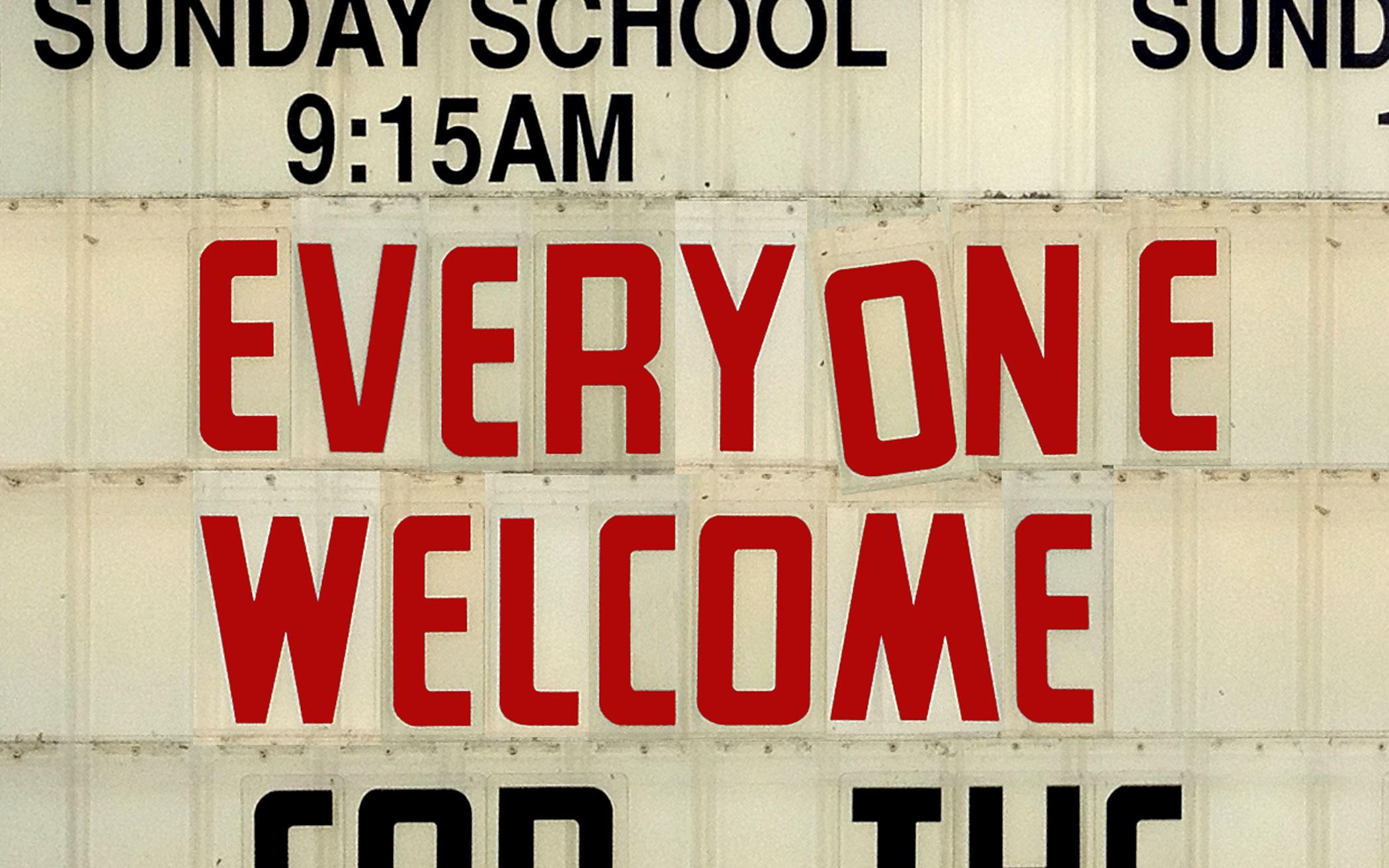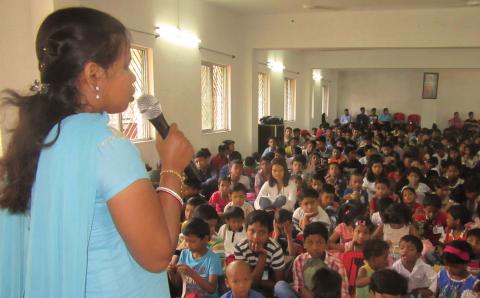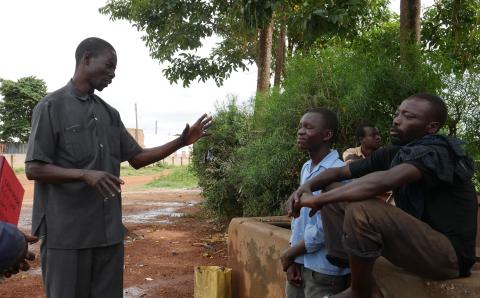Grace Church wants to be known as a welcoming place for all who enter. The words “Everyone Welcome” are prominently featured on the congregation’s website, bulletin, and entryways.
Let’s check in with some of the worshipers and experience that welcome together.
Worship begins as the worship leader steps up to the microphone and says, “Welcome! Everybody stand up and let’s join our voices. . . .”
The elders have prepared the elements for the Lord’s Supper. Small juice cups and bread cubes are stacked and ready.
During the children’s message, the worship leader needs no amplification as he loudly greets the children and invites them to “sing louder.”
The youth group leader prepares for the popular annual treasure hunt by dividing kids into groups.
After the service, the adult small group is ready to meet. They’ve been asked to read a chapter and write their answers to a set of questions in the book they’re discussing.
But has anyone noticed the small print on those “Everyone Welcome” signs?
Amy is a wheelchair user who cringes at the opening words of the worship leader. The service has just started and already she is excluded from the conversation with God. She longs to hear the words “Please rise in body or in spirit.” Now that she could do!
Carlos is eager to celebrate the Lord’s Supper. He checked the bulletin and listened carefully, but there is no gluten-free option. Sadly, he passes the bread to the next person. John is excluded too. The arthritis in his hands makes it impossible to grab and hold such small items.
The Johnson family was taken aback when they dropped Tucker off for Sunday school. Not every child likes the volume turned way up. In fact, loud noise is painful to their son. Tucker beat his parents back to the car.
Courtney had been looking forward to the treasure hunt. This would be her first time participating in youth group. The leaders had prepared for everything except for welcoming someone with Down syndrome. “Sorry, we don’t have anything here for your daughter” were the last words Courtney and her parents heard as they left the room.
Gustav has only been in the United States for a year. English is his second language. He would love the fellowship of an adult small group but wishes there would be an option that did not require so much reading and writing. He longs for the chance to build relationships.
Henry is experiencing the beginning stages of dementia. Words are getting harder to use. He wishes there were a different way of engaging in Bible study and fellowship.
Is everyone really welcome here? Amy, Carlos, John, Tucker, Courtney, Gustav, and Henry wonder if they have missed some sort of small print on the back of that welcome sign. Each has felt excluded from the welcome for various reasons.
So what can Grace Church do to make sure no one is excluded from their welcome?
Adjust the Vision
Expect persons of varied abilities. Persons with disabilities make up a large chunk of any congregation. These folks may include infants with spina bifida, toddlers with Down syndrome, elementary-aged children with attention deficit or a learning disability, young people with autism spectrum disorder, adults with bipolar disorder, and seniors with limited vision, hearing, or mobility. When you also consider those with athletic injuries or other medical situations, people from other countries, and individual preferences, learning to become more welcoming with persons of varied abilities and disabilities will likely impact most members of your congregation.
Look for the gifts each person brings to the community. Understand that everyone is gifted by God to enhance and grow the congregation. It was not simply the individuals mentioned above who lost out at Grace Church that day. Gustav would have brought a whole new dimension to the adult small group. Courtney would influence her peers in youth group and help them grow. Tucker has gifts to share in Sunday school.
Use Elements of Universal Design
Architects had a great idea: Don’t wait until someone needs an elevator before installing one. Instead plan for an elevator in multi-level buildings, expecting that someone will need it.
Churches can follow this same principle. Don’t wait for that person to show up before making some changes. Build times of worship, education, fellowship, and service, expecting persons of varied abilities to attend. Here are some things a congregation could do:
- Install a hearing loop in your sanctuary.
- Provide large-print versions of bulletins and other reading materials.
- Train worship leaders to invite people to “rise in body or in spirit.”
- Equip leaders and volunteers to welcome persons of varied abilities and disabilities.
- Stock children’s areas with fidget pencils, a weighted lap pad, a set of noise-canceling headphones, and a “wiggle cushion” for those who need them. Set some of these items out so parents can see at a glance that their child is anticipated and welcomed.
- Offer a gluten-free bread option for the Lord’s Supper.
- Recognize that most people do not learn and remember with a “words only” approach. A beautiful example of a multisensory experience in our worship is the reminder we often hear before partaking of the Lord’s Supper: “Do this and remember me.” The Lord’s Supper is something we see, touch, taste, smell, and hear. How can we follow this example as we prepare messages and teachings for one another?
- Set up websites to give a virtual tour of the church facility and activities.
- Place sermon notes, PowerPoints, and bulletins on the website so they can be pulled up on individual devices or printed on a Braille printer according to the vision needs of members.
- Offer an adult education option designed to welcome adults of varied abilities (see sidebar).
While universal design will certainly erase most of the “small print” on the welcome sign, it’s also important to have a process in place to respond to the unique gifts and needs of individuals. Maria, for example, may have a communication device that could be programmed to allow her to better participate in church settings. Members of the congregation may need to be trained on how her wheelchair works and how she can safely eat at the Wednesday-night potluck. Be ready to get to know specific individuals and put together a plan so each one can be included.
To become a truly welcoming community, Grace Church needed to adjust its vision as well as discover and implement the principles of universal design. Now their welcome sign contains only the words “EVERYONE WELCOME.” There is no small print.
What about your congregation? What does your welcome sign look like?
Resources for a Welcoming Congregation
Congregational Toolbox: Check out your area of leadership or the role you fill in your congregation and discover how you can help increase the welcome in your community. clcnetwork.org/for-churches/roles/
The Together curriculum published by Friendship Ministries incorporates the concept of universal design. It is an inclusive adult Bible study that allows people of different abilities to learn together. www.togethersmallgroups.org.
Study Questions
- Do any of the examples of Grace Church’s Sunday morning practices reflect those of your own church? Does your church also have “small print,” so to speak, on its welcome sign?
- How many people in your church currently do you know that may have special needs or require special accommodations? Are your church’s current facilities and practices meeting those needs?
- What are some of the gifts persons with disabilities bring to your church community?
- What are some steps your church can take now to improve its inclusiveness or minimize the “small print” in its welcome sign?
About the Author
Barb Newman is a church and school consultant through the CLC (Christian Learning Center) Network. She is a national speaker and author of Helping Kids Include Kids with Disabilities, The Easter Book, and Autism and Your Church. You can contact CLC Network (www.clcnetwork.org) for support in creating individual plans and offering congregational training in the area of inclusion.








